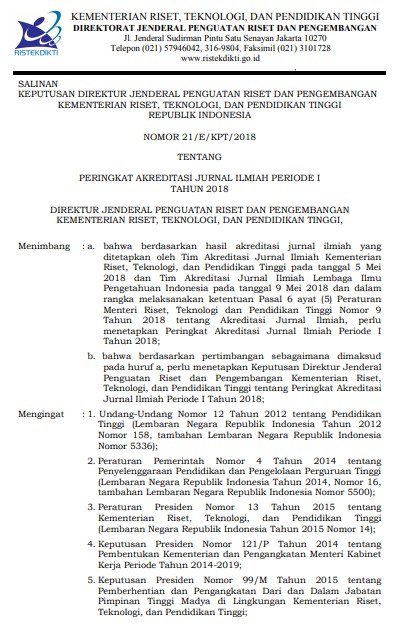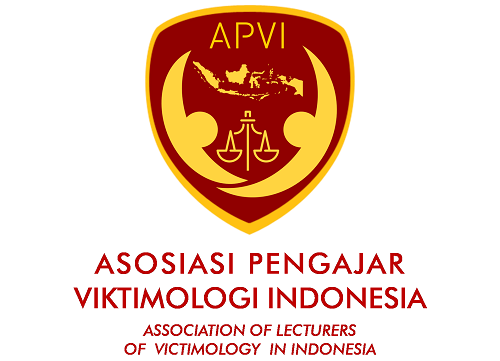Regional Government Policy in the Implementation of Child-Friendly City: An Analysis of Way Kanan District
Abstract
The child-friendly city concept implementation in Way Kanan City is intended to fulfill the needs of children's rights there. This paper aims to contribute to policymakers’ implementation of child-friendly cities, especially in developing countries, by analyzing how child-friendly cities are implemented and the challenges faced. This article was created using socio-legal research methods. The results of this study show that the implementation is carried out by the Office of Women's Empowerment and Child Protection through several stages, namely, KLA development planning in the form of preparing Regional Action Plans, then implementing KLA development in the form of KLA programs’ implementation by involving all resources and implementing child-friendly school programs as well as monitoring and evaluating KLA development regularly. Implementation constraints come from internal factors. Challenges include limited human resources and an inability to understand women's empowerment and child protection issues, which affect socialization. Public facilities also need improvement to meet child-friendly standards. Meanwhile, technical coordination issues and misunderstandings about the KLA program's purpose arise due to external factors. Societal attitudes towards violence as education hinder program implementation. The suggestion for this research is to improve coordination between stakeholders or increase cooperation with partners to overcome problems regarding the lack of human resources, increase the budget and optimize the implementation of child-friendly city efforts.
Full Text:
PDF View
References
Ager, A., Metzler, J., Vojta, M., & Savage, K. (2013). Child friendly spaces: a systematic review of the current evidence base on outcomes and impact. In War Trauma Foundation.
Aristora, I. (2019). MENGANALISIS PERAN ASISTENSI DALAM PEMBANGUNAN DAERAH DI KABUPATEN ACEH BARAT. Ius Civile: Refleksi Penegakan Hukum Dan Keadilan. https://doi.org/10.35308/jic.v3i1.1433
Asiri, H., & Sugirman, A. (2020). CHILDREN’S RIGHTS BEFORE THE LAW: A ROLE OF LOCAL GOVERNMENT IN THE CHILD PROTECTION SYSTEM. Al-Bayyinah. https://doi.org/10.35673/al-bayyinah.v4i2.957
Bagus, D., Satrio, H., Taftazani, B. M., Wibowo, H., Anak, P., & Nomor, U. (2012). 16 Pendampingan Anak Berhadapan Dengan Hukum. 11, 84–89.
Bariah, O., & Marlina, R. (2019). Tinjauan Psikologi dan Agama Terhadap Tindak Kekerasan pada Anak. Jurnal Studia Insania. https://doi.org/10.18592/jsi.v7i2.2646
Bartlett, S., Bartlett, S., Bartlett, S., Bartlett, S., Bartlett, S., Bartlett, S., & Bartlett, S. (2005). Integrating Children’s Rights into Municipal Action: A Review of Progress and Lessons Learned. Children, Youth and Environments. https://doi.org/10.1353/cye.2005.0020
Bisma Parneto, A., & Tua Ricky Freddy Simanjuntak, H. (2022). Implementasi Kebijakan Kota Layak Anak (Kla) Di Kabupaten Kampar. Cross-Border, 5(1), 766–781.
BKKP Batam. (2023). PELATIHAN KONVENSI HAK ANAK BAGI SELURUH GUGUS TUGAS KLA BATAM. 15 Mei 2023.
Britto, P. R., & Ulkuer, N. (2012). Child development in developing countries: Child rights and policy implications. Child Development. https://doi.org/10.1111/j.1467-8624.2011.01672.x
Cleek, E. A., Johnson, N. L., & Sheets, L. K. (2019). Interdisciplinary collaboration needed in obtaining high-quality medical information in child abuse investigations. Child Abuse and Neglect. https://doi.org/10.1016/j.chiabu.2019.02.012
CNBC Indonesia. (2023). 19 Kota Layak Anak 2023 menurut KemenPPPA.
Cordero Vinueza, V. A., Niekerk, F. (Femke), & van Dijk, T. (Terry). (2023). Making child-friendly cities: A socio-spatial literature review. Cities, 137(February), 104248. https://doi.org/10.1016/j.cities.2023.104248
Deliza Eryani, N. (2020). Kebijakan Pemerintahan Daerah dalam Pengelolaan Kerusakan Lingkungan Hidup di Kabupaten Sijunjung dan Kabupaten Dharmasraya. Jurnal Demokrasi Dan Politik Lokal.
Derr, V., Chawla, L., Mintzer, M., Cushing, D. F., & Van Vliet, W. (2013). A city for all citizens: Integrating children and youth from marginalized populations into city planning. Buildings. https://doi.org/10.3390/buildings3030482
Derr, V., & Tarantini, E. (2016). “Because we are all people”: outcomes and reflections from young people’s participation in the planning and design of child-friendly public spaces. Local Environment. https://doi.org/10.1080/13549839.2016.1145643
Dwi Puspitasari, Mamluatul Hani’ah, Candra Bella Vista, Ika Kusumaning Putri, & Wilda Imama Sabila. (2021). Workshop Pemanfaatan Teknologi untuk Memantau Tumbuh Kembang dan Kesehatan Balita. Jurnal Pengabdian Polinema Kepada Masyarakat. https://doi.org/10.33795/jppkm.v8i2.49
Elizabeth, A., Hidayat, Z., & Publik, J. A. (2016). Implementasi Program Kota Layak Anak Dalam Upaya Pemenuhan Hak-Hak Anak Di Kota Bekasi. Journal of Public Policy and Management Review, 5(2), 55–70.
Hastuti, S. K. W., Baginda, N. C., & Aprianda, S. (2022). A QUALITATIVE STUDY: HOSPITAL PATIENT COMPLAINT MANAGEMENT. Indonesian Journal of Health Administration. https://doi.org/10.20473/jaki.v10i1.2022.31-40
Jansson, M., Herbert, E., Zalar, A., & Johansson, M. (2022). Child-Friendly Environments—What, How and by Whom? In Sustainability (Switzerland). https://doi.org/10.3390/su14084852
Jeffrey M. Jenson Ph.D., Maxine Jacobson M.S.W, Y. U. P. D. & R. L. R. M. S. . (1996). Interevention for victims of child sexual abuse: An evaluation of the Children’s Advocacy Model. Child and Adolenscent Social Work Journal, 12, 139–156. https://doi.org/https://doi.org/10.1007/BF01876643
Jody, I. N. S., Armaeni, N. K., & Triswandana, I. W. G. E. (2021). RENCANA KESELAMATAN KONSTRUKSI PROYEK PEMBANGUNAN SMAN 9 DENPASAR PADA TAHAP STRUKTUR. Jurnal Teknik Gradien. https://doi.org/10.47329/teknikgradien.v13i2.755
K. Alzayer, A. A. et al. A. A. (2019). Analyzing and Implementing a System For Reporting, Follow Up and Resolving of Complaints. International Research Journal of Engineering and Technology (IRJET).
Kasapa, A., & Gyan, C. (2023). Community Participation in Planning Social Infrastructure Delivery in Ghana’s Local Government: A Case Study of Shai Osudoku District. Journal of Development Policy and Practice. https://doi.org/10.1177/24551333231165831
Kramer, T., Sigel, B., Conners-Burrow, N., Worley, K., Church, J., & Helpenstill, K. (2015). It Takes a State: Best Practices for Children Exposed to Trauma. Best Practices in Mental Health.
Krishnakumar, P., & Geeta, M. G. (2011). Child friendly school initiative program. In Indian pediatrics.
Latifah, A. L., Ramli, B., & Fard, P. Y. (2010). Improving accessibility and responsiveness in a complaints management system. E-Leader Singapore.
LESTARI DEWI, A., & Alimuddin. (2022). Penegakan Hukum terhadap Tindak Kejahatan Asusila Anak di Kota Kendari. Arus Jurnal Sosial Dan Humaniora. https://doi.org/10.57250/ajsh.v2i2.86
Madiun, D. (2023). WUJUDKAN KABUPATEN LAYAK ANAK, TONTRO BUKA PELATIHAN KONVENSI HAK ANAK.
Maknun, L. (2017). Kekerasan terhadap anak yang dilakukan oleh orang tua (child abuse). Jurnal Muallimuna Madrasah Ibtidaiyah.
Malone, K. (2009). Designs for a child-friendly city. Curriculum Leadership.
Malti, T. (2020). Children and Violence: Nurturing Social‐Emotional Development to Promote Mental Health. Social Policy Report. https://doi.org/10.1002/sop2.8
Mizrak, B., Mattia, S., & Pandolfi, A. (2014). Where We Grow up does Really Matter: Best Practices for Child-Friendly Cities Applied in Tarlabaşı (Istanbul). Environment and Ecology Research. https://doi.org/10.13189/eer.2014.020501
Mulyani, T., Muryati, D. T., & Kridasaksana, D. (2019). PENINGKATAN PEMAHAMAN SISWA SMK PANDANARAN SEMARANG MENGENAI PENTINGNYA MENANAMKAN NILAI KEBHINNEKAAN DALAM RANGKA MENJAGA KEUTUHAN NKRI. Jurnal Dinamika Sosial Budaya. https://doi.org/10.26623/jdsb.v20i2.1245
Nabilah Muhamad, databoks. (2023). Kekerasan Terhadap Perempuan dan Anak di Lampung Capai 307 Kasus hingga Pertengahan 2023.
NAVARRA, E. M. (2019). The Goals of a Child-Friendly School and the Psycho-Social Environment of the Learners in Public Secondary Schools in the Division of Butuan City, Philippines. SMCC Higher Education Research Journal. https://doi.org/10.18868/sherjte.01.060119.13
Osofsky, J. D. (2004). Community outreach for children exposed to violence. In Infant Mental Health Journal. https://doi.org/10.1002/imhj.20020
Pastin, M. J. (1999). Compliance hotlines: practical advice for implementing a reporting mechanism. Radiology Management.
Redmond, M., & Martin, B. (2023). All in the (Definition of) Family: Transnational Parent–Child Relationships, Rights to Family Life, and Canadian Immigration Law. Journal of Family Issues. https://doi.org/10.1177/0192513X211054461
Reksodiputro, M. (2010). Rekonstruksi Sistem Peradilan Pidana Indonesia. Jurnal Lex Specialis.
Riggio, E. (2002). Child friendly cities: Good governance in the best interests of the child. Environment and Urbanization, 14(2), 45–58. https://doi.org/10.1177/095624780201400204
Saridar Masri, S. (2018). Integrating youth in city planning: Developing a participatory tool toward a child-friendly vision of Eastern Wastani – Saida. Alexandria Engineering Journal. https://doi.org/10.1016/j.aej.2017.01.023
Schoeppich, Koller, & McLaren. (2021). Children’s Right to Participate in Playground Development: A Critical Review. Children, Youth and Environments. https://doi.org/10.7721/chilyoutenvi.31.3.0001
Shadkam, A., & Moos, M. (2021). Keeping young families in the centre: a pathways approach to child-friendly urban design. Journal of Urban Design. https://doi.org/10.1080/13574809.2021.1917984
Stoltenberg, J. (2006). Our children: the key to our common future. In Lancet. https://doi.org/10.1016/S0140-6736(06)69332-X
UNICEF. (n.d.). What is a child friendly city?
Whitzman, C., Worthington, M., & Mizrachi, D. (2010). The journey and the destination matter: Child-Friendly Cities and children’s right to the City. Built Environment. https://doi.org/10.2148/benv.36.4.474
Wilks, J. (2010). Child-Friendly cities: A place for active citizenship in geographical and environmental education. International Research in Geographical and Environmental Education. https://doi.org/10.1080/10382040903545484
Wulandari, R., & Suteja, J. (2019). Konseling Pendidikan Seks dalam Pencegahan Kekerasan Seksual Anak (KSA). Prophetic : Professional, Empathy and Islamic Counseling Journal. https://doi.org/10.24235/prophetic.v2i1.4751
XU, M., SHEN, Y., LIAO, Y., & Helen, W. (2020). EVALUATION INDICATORS OF CHILDREN’S MOBILITY SAFETY IN THE COMMUNITY ENVIRONMENT BASED ON ENGLISH LITERATURE REVIEW. Landscape Architecture Frontiers. https://doi.org/10.15302/j-laf-1-020026
Zellman, G. L. (1990). Linking Schools and Social Services: The Case of Child Abuse Reporting. Educational Evaluation and Policy Analysis. https://doi.org/10.2307/1163586
Zomerplaag, Jaap and Mooijman, A. (2005). Child-Friendly Hygiene and Sanitation. IRC International Water and Sanitation Centre.
DOI: http://dx.doi.org/10.20884/1.jdh.2024.24.1.4283
Refbacks
- There are currently no refbacks.
JURNAL DINAMIKA HUKUM Indexed by :
 | Jurnal Dinamika Hukum | |
| Faculty of Law, Universitas Jenderal Soedirman | Copyright of Jurnal Dinamika Hukum | |
| Yustisia IV Building, Law Journal Center | ISSN 2407-6562 (Online) ISSN 1410-0797 (Print) | |
| Purwokerto, Central Java, Indonesia, 53122 | JDH is licensed under a Creative Commons Attribution 4.0 International License | |






